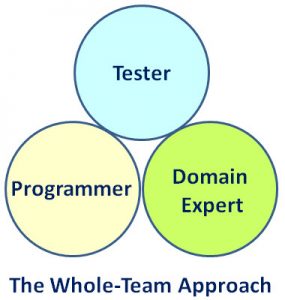ISTQB Agile Tester Extension Exam Theory Study Material Part 1
Have a deep study of this entire question bank containing theory portion with detailed explanation. This study resource is as per the latest syllabus released in 2014.
Just 1 hr. of time spent in brushing up your knowledge just before the ISTQB Agile Tester Extension Exam shall be of great help in clearing it.
Right now the theoretical crash course has 150 questions. We shall be uploading additional questions very shortly.
Set of 10 Questions (Q. 1 to 10) with detailed explanation
Q. 1: What is an Agile Manifesto?
Agile Manifesto is a standard document prescribing a common set of values and principles for Agile Software Development decided jointly by certain experts in the field of software development and testing. This document describes better ways of software development and was called – Manifesto or “The Agile Manifesto”.
The first Agile Manifesto was released by agilemanifesto.org in the year 2001.
<<<<<< =================== >>>>>>
Q. 2: What are the statements of values of the Agile Manifesto?
The Agile Manifesto prescribes four statements of values as given below.
| Agile Concepts | Traditional Concepts | |
| 1 | Individuals and interactions | Processes and tools |
| 2 | Working software | Comprehensive documentation |
| 3 | Customer collaboration | Contract negotiation |
| 4 | Responding to change | Following a plan |
The concepts prescribed in the Agile Manifesto are “Statements of Emphasis” mentioned in the left column.
Although there is value in the “Traditional Concepts” mentioned in the right column, yet we value the “Agile Concepts” mentioned in the left column more.
<<<<<< =================== >>>>>>
Q. 3: What is Agile development methodology?
1) In the Agile approach, each project is broken up into several ‘Iterations’.
2) All Iterations should be of the same time duration (between 2 to 8 weeks).
3) At the end of each iteration, a working product should be delivered.
4) In simple terms, in the Agile approach the project will be broken up into 10 releases (assuming each iteration is set to last 4 weeks).
5) Rather than spending 1.5 months on requirements gathering, in Agile software development, the team will decide the basic core features that are required in the product and decide which of these features can be developed in the first iteration.
6) Any remaining features that cannot be delivered in the first iteration will be taken up in the next iteration or subsequent iterations, based on priority.
7) At the end of the first iterations, the team will deliver a working software with the features that were finalized for that iteration.
8) There will be 10 iterations and at the end of each iteration, the customer is delivered a working software that is incrementally enhanced and updated with the features that were shortlisted for that iteration.
<<<<<< =================== >>>>>>
Q. 4: Why Agile core-values are preferred over Traditional Concepts?
Agile Core Value-1: Individuals and Interactions:
# The Agile development is more centered on people.
# It emphasizes that it is a team of people that build software through continuous communication and interaction, instead of totally depending upon the tools or processes.
# Each individual of the agile team contributes his/her best towards the development project.
Agile Core Value-2: Working Software:
# For a customer working software is much more useful and significant than its documentation.
# Of course comprehensive documentation is also important because it provides an opportunity to give a quick feedback to the development team.
# In agile projects, a software product requirement is said to be done is when a truly working product feature associated with that particular requirement is available.
Agile Core Value-3: Customer Collaboration:
# Generally it is very difficult for the customers to specify the system they need.
# By close collaboration with the customer the agile team can clearly understand their requirements.
# Neatly defined contracts signed by the customers are important. However, working in regular and close collaboration with the customers and making them a part of the project is still more important for the success of the project.
Agile Core Value-4: Responding to Change:
# Change are an inherent part of the software development projects.
# Flexibility of working to accommodate changes in the development process is far more important rather than rigidly sticking to a particular plan.
<<<<<< =================== >>>>>>
Q. 5: What are the 12 Agile Principles?
Following agile principles are the set of guidelines based upon the four core values of the agile manifesto.
1) Topmost priority is to satisfy the customer through an early & continuous delivery of the valuable software product.
2) Always welcome the changes in requirements from the customers, may be quite late during the development cycle. The customer might be able to get some competitive advantage due to the changes.
3) Deliver working software more frequently. The delivery intervals can range from few weeks to few months. Preference must be for a shorter timescale.
4) The whole team of business people and developers must collaborate daily throughout the project.
5) Build agile projects with the help of motivated team members. Provide a healthy environment and all-round support to the team and have trust in them.
6) Encourage face-to-face conversation among all the members of the development team so that the information gets communicated effectively.
7) The primary measure of progress and success of the project is the availability of the working software.
8) Encourage sustainable development. Constant pace of development must be maintained throughout the development process by the sponsors, developers, and users.
9) Emphasize on technical excellence and good design by the continuous attention.
10) Emphasize on simplicity with a greater focus on work not done.
11) Encourage self-organizing teams for getting best outputs like software architectures, requirements, and designs.
12) Emphasize on retrospective meetings at regular and frequent intervals so that the teams can become more effective.
<<<<<< =================== >>>>>>
Q. 6: What are the benefits of Agile Methodology?
1) In Agile methodology the delivery of software is unremitting.
2) The customers are satisfied because after every Sprint working feature of the software is delivered to them.
3) Customers can have a look at the working feature which fulfilled their expectations.
4) If the customer has any feedback or any change in the feature then it can be accommodated in the current release of the product.
5) In Agile methodology, the daily interactions are required between the business people and the developers.
6) In this methodology, attention is paid to the good design of the product.
7) Changes in the requirements are accepted even in the later stages of the development.
<<<<<< =================== >>>>>>
Q. 7: What are the drawbacks of the Agile Methodology?
1) In Agile methodology, the documentation is less.
2) Sometimes in Agile methodology, the requirement is not very clear hence it’s difficult to predict the expected result.
3) In few of the projects at the starting of the software development lifecycle, it’s difficult to estimate the actual effort required.
4) The projects following the Agile methodology may have to face some unknown risks which can affect the development of the project.
<<<<<< =================== >>>>>>
Q. 8: What is Whole-Team Approach or team-based approach in agile development?
# The whole-team approach means involving everyone with the knowledge and skills necessary to ensure project success. The team includes representatives from the customer and other business stakeholders who determine product features.
# The whole team is responsible for achieving the desired quality levels in Agile projects.

# The team size must be small. Team size between 3 and 9 is usually quite successful.
# Ideally, the whole team must share the same workspace to strongly facilitate communication and interaction.
# The whole-team approach is supported through the daily stand-up meetings involving all members of the team, where work progress is communicated and any difficulties in the progress are highlighted.
# The whole-team approach promotes more effective and efficient team dynamics.
# Testers, developers, and the business representatives work together in every step of the development process like creating suitable acceptance tests, agreeing on a testing strategy, and deciding on test automation approaches.
<<<<<< =================== >>>>>>
Q. 9: What are the benefits of the whole-team approach in Agile product development?
Main benefits of the whole-team approach are:
1) It enhances the communication and collaboration within the team.
2) It helps the team in building strong working relationships through effective cooperation, teamwork, and communication.
3) It enables the various skill sets within the team to be leveraged for the benefits of the project.
4) It helps team members to learn and share knowledge with each other.
5) It makes quality the responsibility for everyone.
6) It makes everyone collectively responsible for the outcome
<<<<<< =================== >>>>>>
Q. 10: What is “Power of Three”?
# In the whole-team approach, all team members get involved during discussions/meetings for presentation, analysis or estimation of product features.
# The concept of involving testers, developers, and domain experts or business representatives in all product feature discussions is known as the “Power of Three”.
# All these three work together with an agile mindset with an understanding that all share the success and failure together.
ISTQB Agile Tester Extension Exam Theory Study Material Part 2

An expert on R&D, Online Training and Publishing. He is M.Tech. (Honours) and is a part of the STG team since inception.
